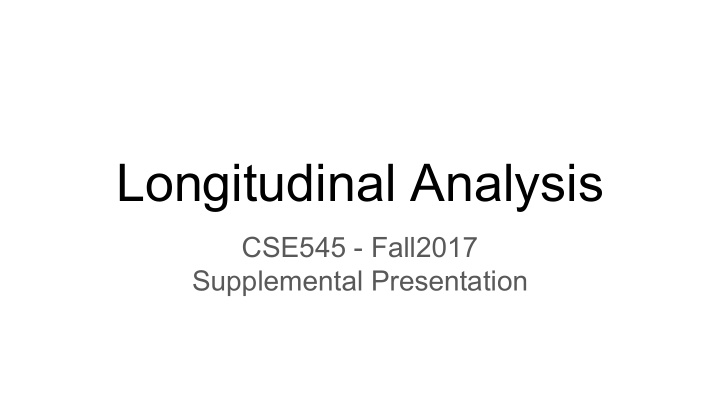



Longitudinal Analysis CSE545 - Fall2017 Supplemental Presentation
Introduction Time Series Analysis Goal: Understanding temporal patterns of data (or real world events) Common tasks: ● Trend Analysis: Extrapolate patterns over time (typically descriptive). ● Forecasting: Predicting a future event (predictive). (contrasts with “cross-sectional” prediction -- predicting a different group)
Introduction to Causal Inference (Revisited) X causes Y as opposed to X is associated with Y Changing X will change the distribution of Y. X causes Y Y causes X
Spurious Correlations Extremely common in time-series analysis.
Spurious Correlations Extremely common in time-series analysis. http://tylervigen.com/spurious-correlations
Introduction to Causal Inference (Revisited) X causes Y as opposed to X is associated with Y Changing X will change the distribution of Y. X causes Y Y causes X Counterfactual Model: Exposed or Not Exposed: X = 1 or 0 Causal Odds Ratio:
Autocorrelation “(a.k.a. Serial correlation).” Quantifying the strength of a temporal pattern in serial data. Requirements: ● Assume regular measurement (hourly, daily, monthly...etc..)
Autocorrelation Quantifying the strength of a temporal pattern in serial data. Which have temporal patterns?
Autocorrelation Quantifying the strength of a temporal pattern in serial data. strong autocorrelation white noise Which have temporal sinusoidal patterns? weak autocorrelation
Autocorrelation Quantifying the strength of a temporal pattern in serial data. Q: HOW?
Autocorrelation Quantifying the strength of a temporal pattern in serial data. Q: HOW? A: Correlate with a copy of self, shifted slightly. ….
Autocorrelation Quantifying the strength of a temporal pattern in serial data. Q: HOW? A: Correlate with a copy of self, shifted slightly. Y = [3, 4, 4, 5, 6, 7, 7, 8] correlate(Y[0:7], Y[1:8]) #lag=1 correlate(Y[0:-2], Y[2:8]) #lag=2 ….
Autocorrelation Quantifying the strength of a temporal pattern in serial data. Q: HOW? A: Correlate with a copy of self, shifted slightly. Y = [3, 4, 4, 5, 6, 7, 7, 8] correlate(Y[0:7], Y[1:8]) #lag=1 correlate(Y[0:-2], Y[2:8]) #lag=2 ….
Autoregressive Model AR Models: Linear AR model:
Autoregressive Model AR Models: Linear AR model: Notation:
Autoregressive Model AR Models: Linear AR model: Notation:
Moving Average Based on error; (a “smoothing” technique). Q: Best estimator of random data (i.e. white noise)?
Moving Average Based on error; (a “smoothing” technique). Q: Best estimator of random data (i.e. white noise)? A: The mean
Moving Average Based on error; (a “smoothing” technique). Q: Best estimator of random data (i.e. white noise)? A: The mean Simple Moving Average
Moving Average Model In a regression model (AR MA or ARI MA ), we consider error terms
Moving Average Model In a regression model (AR MA or ARI MA ), we consider error terms
Moving Average Model In a regression model (AR MA or ARI MA ), we consider error terms attributed to “shocks” -- independent, from a normal distribution Notation:
ARMA Models AutoRegressive (AR) Moving Average (MA) Model ARMA(p, q): ARMA(1, 1): example: Y is sales; error may be effect from coupon or advertising ( credit: Ben Lambert )
ARIMA I = Integrated Makes a time series stationary: ● Removes trends (“detrending”) ● Makes “mean reverting” = tendency to always revert back to the mean over the long run. ● Removes changes in variance
Time-series Applications ● ARMA ○ Economic indicators ○ System performance ○ Trend analysis (often situations where there is a general trend and random “shocks”) ● Univariate Models in General ○ Anomaly Detection ○ Forecasting ○ Season Trends ○ Signal Processing ● Integration as predictors within multivariate models statsmodels.tsa.arima_model
Recommend
More recommend